
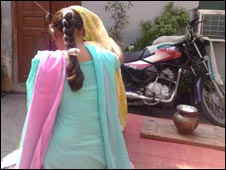 One of our goals on The Langar Hall is to raise awareness about issues affecting our community around the globe. Whether or not we identify or relate to these specific issues may not be as important as much as the acknowledgement that these issues do occur and that individuals and families and even children are affected. We hope that by raising awareness we can begin, as a community, to stand up against injustice in all its forms.
One of our goals on The Langar Hall is to raise awareness about issues affecting our community around the globe. Whether or not we identify or relate to these specific issues may not be as important as much as the acknowledgement that these issues do occur and that individuals and families and even children are affected. We hope that by raising awareness we can begin, as a community, to stand up against injustice in all its forms.
A recent article from the BBC reports that, according to campaigners in Punjab, British Asians are hiring contract killers to carry out up to 100 murders in India each year. One of the most well known cases is that of Surjit Athwal, a British Sikh woman who disappeared in Punjab in 1998. Eventually it was revealed that she had been murdered in a so-called honor killing after her in-laws discovered that she planned to divorce her husband. They had hired criminals in India to kill her. She was strangled and her body dumped in a river. Her brother, Jagdeesh Singh, now campaigns for other victims’ families.
“I think Surjit’s case exposed for the first time in this country overseas outsourced killings. How the Punjabi community, settled in Britain, send their females back to the land of origin, in the full knowledge that they can have them murdered easily, swiftly and efficiently.” [link]
On many occasions, I have noted my dismay at the joke of journalism that calls itself the Times of India. They never cease to provide stupid nonsensical and ill-researched articles. Here is one more example.
It appears that the writer ‘Divya A’ has recently been making his/her rounds at various Sikh film screenings and festivals. Instead of lauding a young community on its tenacity to promote arts and encourage creativity in the community, the author can only wonder:
But how healthy is it for a community to focus on a painful past and present itself to the world as a suffering and wronged people?[link]
Who is the author to decide what is right or wrong for the community?
The author continues to push a nonsensical ‘Khalistani’ conspiracy theory as the raison d’etre behind the shift to visual arts. Instead of looking at the broader context of the proliferation of youtube with film and television being the visual media of the masses, the author believes there is something far more sinister.
Coblogged by Reema and Sundari
There is a deafening silence that surrounds Punjabi-Sikh women. Too often, when discussing challenges that some women may be facing, the conversation is shut down and de-legitimized by one or two angry voices. Interwoven into this is the unrelenting identity debate of labeling actions “Punjabi” versus “Sikh” which often distracts us from the true issue at hand.
 For example, recent posts about issues affecting women turned out to be way more controversial to a few commentors than anything in the original post merited. A post on forced marriages drew virulent ire from a few readers for discussing forced marriages under a title that included the word “Sikh.” A post on a change in asylum law which also included “Sikh” in the title drew the same virulent response. Earlier in the year, a post named “The Rise and Fall of Sikh Girls,” was accused of creating unnecessary attention with it’s title.
For example, recent posts about issues affecting women turned out to be way more controversial to a few commentors than anything in the original post merited. A post on forced marriages drew virulent ire from a few readers for discussing forced marriages under a title that included the word “Sikh.” A post on a change in asylum law which also included “Sikh” in the title drew the same virulent response. Earlier in the year, a post named “The Rise and Fall of Sikh Girls,” was accused of creating unnecessary attention with it’s title.
This reaction is reminiscent of the treatment that was meted to Harshinder Kaur by an Indian government official when she attempted to talk about female feticide in Geneva.
She said in her talk at Geneva she had pointed that it was very essential to educate the women and girls of Punjab to make them aware of their rights and to alleviate their sufferings. For this, UN must give aid to needy girls in their education directly as it should reach at grass level where the aid is not reaching. She said he is giving monetary help to 300 needy girls for their education through her own trust. This issue was disliked by a participant P. Srivastava and she [sic] threatened her after she finished her talk and came out of hall and advised her not to visit UN ever again if she has to utter any [words against the] government. She clarified repeatedly that said [sic] she has not uttered anything about government but was worried only about education of poor girls of Punjab. [PunjabNewsline ]
Besides the insult felt by readers at the idea of Sikhs not living as Sikhs should and the fear that a negative image of Sikhs was being portrayed, there is another stream of thought shutting down these conversations that I think needs to be addressed.
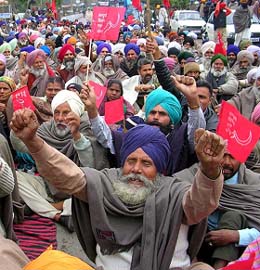 While I do value the role films play in telling stories, I wonder if at times it can do more harm than good. I recently heard about a new bollywood movie called Kisaan and had the opportunity to watch it last night. I had been told the movie was about farmer suicides in punjab and while i was aware it was a bollywood production, I definitely made time to watch it as it is such an important issue.
While I do value the role films play in telling stories, I wonder if at times it can do more harm than good. I recently heard about a new bollywood movie called Kisaan and had the opportunity to watch it last night. I had been told the movie was about farmer suicides in punjab and while i was aware it was a bollywood production, I definitely made time to watch it as it is such an important issue.
The movie touched upon issues such as the role illiteracy and dowry play in the lives of farmers – the reality of poverty overpowered by the hope of prosperity. These are important issues and should be discussed. Films are an important tool to utilize in order to raise awareness about such issues.
Suffice it to say, Kisaan is a bollywood production and is distracted by it’s commitment to bollywood requirements. I can’t say i wasn’t disappointed – this is such an important issue which needs to be explored. While i commend the director for attempting to raise the issue, i do question if this genre of film was the best vehicle for it. The issue was so entangled in the film, mixed in with songs and awkward jokes, that i can’t imagine how serious the issue will be taken.
 When hallowed grounds make way for fairway greens, you have a lens into contemporary elite culture in Punjab. Tales of the loss of our historical materials and architecture form a common topic here in The Langar Hall as throughout conversations of Sikhdom. Destruction of historic Gurdwaras for the vanilla blandness of marble monstrosities is well known.
When hallowed grounds make way for fairway greens, you have a lens into contemporary elite culture in Punjab. Tales of the loss of our historical materials and architecture form a common topic here in The Langar Hall as throughout conversations of Sikhdom. Destruction of historic Gurdwaras for the vanilla blandness of marble monstrosities is well known.
Although I am hardly a fan of the Times of India, a recent article did get me to think.
The article describes a hallowed space that will soon become a golfing green. The history of that space is as follows:
Barely 20 km away from Chandigarh, off Kharar-Landran road, lies Chhappar-Chiri village — once known for its plentiful ponds and mangroves on the banks of Patiala Ki Rao — where in 1710, the brave Banda Singh, anointed general of the Khalsa army by Guru Gobind Singh and sent to stop the tyranny of Mughals, defeated the army of Wazir Khan, the subedar of Sirhind who had ordered the killing of Sahibzada Zoravar Singh and Fateh Singh by bricking them alive. Khan was put to death and his body dragged to Sirhind, about 25 km from the village, before the Khalsa army proceeded to decimate the town.[link]
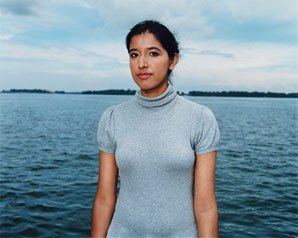 Jasmeet Kaur Sidhu is a 21-year-old aspiring journalist, who currently writes a climate blog for the Toronto Star (she even has The Langar Hall listed as one of her links!). She was recenly chosen as one of the Top 10 College Women for Glamour Magazine (hat tip: Maple Leaf Sikh). The award is usually given out to college students in the US, however, Jasmeet (a Canadian) was picked to be part of the group this year!
Jasmeet Kaur Sidhu is a 21-year-old aspiring journalist, who currently writes a climate blog for the Toronto Star (she even has The Langar Hall listed as one of her links!). She was recenly chosen as one of the Top 10 College Women for Glamour Magazine (hat tip: Maple Leaf Sikh). The award is usually given out to college students in the US, however, Jasmeet (a Canadian) was picked to be part of the group this year!
Jasmeet is the founder of the Peel Environmental Youth Alliance (PEYA), a network of students in the Peel Region working to implement environmental programs in all 220 Peel Region schools. She is currently studying Peace and Conflict Studies at the University of Toronto. Her dream is to become an international journalist.
As a sophomore, Sidhu wrote to the Toronto Star suggesting ways for the paper to improve its coverage. She was promptly asked to join the Community Editorial Board—the youngest member ever—and soon started writing opinion columns for the Star, Canada’s largest newspaper. Sidhu, whose family moved from Malaysia to Canada when she was a baby, has covered everything from HIV/AIDS in Africa to climate change. As the peace and conflict major says, “My mother used to deliver the Star when we first came to Canada. Now her daughter writes for the very same newspaper. Amazing, right?!”
 Last week, Reema discussed the dynamic Punjabi-Sikh art scene. We’ve come a long way, especially in the field of film and media with a growing number of films by, for and about Sikhs. Now, you can attend Sikh film festivals in every corner of the country and even internationally. In addition to this, Sikhnet recently announced it’s 2009 Youth Online Film Festival. This online film festival is especially significant as it offers young inspired Sikhs an opportunity to showcase their creativity on a positive platform. Films such as turBAN, a film by Dashmesh Pictures and G.N.E., provides an “artistic editorial challenging current regulations invoked in the French public school system.” Each film plays an important role in portraying Sikh stories in creative ways.
Last week, Reema discussed the dynamic Punjabi-Sikh art scene. We’ve come a long way, especially in the field of film and media with a growing number of films by, for and about Sikhs. Now, you can attend Sikh film festivals in every corner of the country and even internationally. In addition to this, Sikhnet recently announced it’s 2009 Youth Online Film Festival. This online film festival is especially significant as it offers young inspired Sikhs an opportunity to showcase their creativity on a positive platform. Films such as turBAN, a film by Dashmesh Pictures and G.N.E., provides an “artistic editorial challenging current regulations invoked in the French public school system.” Each film plays an important role in portraying Sikh stories in creative ways.
Another notable film-related event is Visions of Truth, a traveling film festival devoted to showcasing films about 1984. The film festival will be held during the months of September and October in eight regions in California including: Yuba City, Sacramento, San Jose, Fresno, Los Angeles, Irvine, Riverside and San Diego.
The goal of “Visions of Truth” is to spur dialogue between members of the community by showcasing film and music media related to the third Sikh holocaust (1984). This event remains one the most significant, events in the history of Sikhs. In early June 1984 the Indian Army invaded one of the most historic of all Sikh Gurdwaras, the Darbar Sahib complex in Amritsar, Punjab. The ensuing destruction and loss of life marked one of the darkest chapters of the later 20th century for Sikhs. The aim of the film festival is not only to remember the events of 1984 but also to raise awareness in the community and promote positive dialogue. [link]
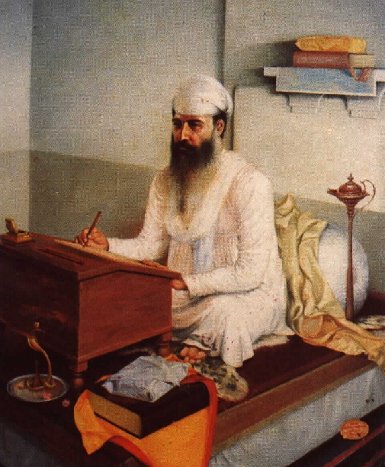 Sikh scholars have a long and proud history from Bhai Gurdas to Giani Ditt Singh and Sardar Kapoor Singh with too many to name in between. Although in more recent times some academics have been seen as controversial in the community, a confident community celebrates academic conferences that provide a valuable forum for those interested to exchange thoughts, discussions, and ideas. This past weekend, one such conference occurred in Berkeley, titled “After 1984” and was an example of the critical importance of scholarly exchange, bringing together such luminaries as Gurharpal Singh, Pal Singh Ahluwalia, Arvindpal Singh Mandair, and many others.
Sikh scholars have a long and proud history from Bhai Gurdas to Giani Ditt Singh and Sardar Kapoor Singh with too many to name in between. Although in more recent times some academics have been seen as controversial in the community, a confident community celebrates academic conferences that provide a valuable forum for those interested to exchange thoughts, discussions, and ideas. This past weekend, one such conference occurred in Berkeley, titled “After 1984” and was an example of the critical importance of scholarly exchange, bringing together such luminaries as Gurharpal Singh, Pal Singh Ahluwalia, Arvindpal Singh Mandair, and many others.
Despite the intellectual brilliance, the meeting point between activism and the academy has always been somewhat uneasy. This weekend allowed such an exchange to occur, but was hardly the focus of the conference. The Jakara Movement is aiming to bridge this gap early next year with its first annual Sikholars: Sikh Graduate Student Conference.
To be held at Stanford University on February 20th, 2010, the organizers are soliciting the community’s help in broadcasting the news of this first conference and calling for proposals. The deadline for abstract submission is NOVEMBER 15, 2009.
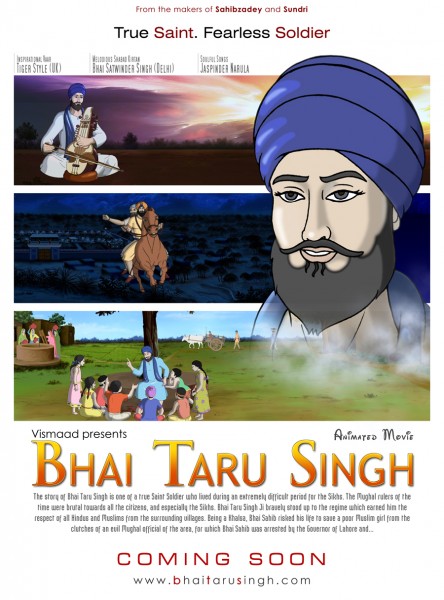 babania kehania put saput karaen ||
babania kehania put saput karaen ||
The stories of one’s ancestors make the children good children.
(Guru Amar Das, Raag Raamkalee, Page 951 of Guru Granth Sahib)
The American writer Muriel Rukeyser once said that the universe is made up, not of atoms, but of stories. This especially holds true for the Sikh universe. Stories or anecdotes from our short but action-packed history provide us with guidance, inspiration and resilience. Who needs fictional super-heroes when the Sikh narrative provides us with so many real-life heroes who did extraordinary things?
For most Sikhs, myself included, these Sikh stories told to us by our parents and grandparents were an essential part of growing up Sikh. However, we’re quickly losing this great oral tradition. For a variety of reasons, parents and grandparents aren’t telling sakhis like they used to and kids aren’t listening to them.
Continue Reading »
In many ways, the Punjabi-Sikh art scene is expanding exponentially these days. Just 10 years ago, beyond major, mainstream singers, I don’t think there was an arts scene, except maybe in people’s homes. Today, there are film festivals in most major cities like Spinning Wheel and the upcoming Sikh Heritage Film Fest in NY, art exhibits in museums such as the recent exhibit at NY’s Rubin Museum and current exhibit at the London’s Victoria and Albert, and even spoken word shows like When Lions Roar and Lahir. There are independent artists writing thoughtful lyrics, creating original beats, and giving some of our community’s concerns a voice. One of my favorites from this summer is Humble the Poet’s “Singh with Me” featuring Sikh Knowledge.
Yet, while the number and modes of art and artists grows in our community, many mainstream musicians are following  mainstream trends… videos featuring flashy cars rented for the shot, women as props, all at some party. Maybe they’re catering to what they think the audience wants, but the audience is clamoring for what they see as glamorous… which is manufactured to cater to the whims of the audience. This degenerative, downward spiral has led to recent hits such as RDB’s “Om Mangalam.” (See end of post.)
mainstream trends… videos featuring flashy cars rented for the shot, women as props, all at some party. Maybe they’re catering to what they think the audience wants, but the audience is clamoring for what they see as glamorous… which is manufactured to cater to the whims of the audience. This degenerative, downward spiral has led to recent hits such as RDB’s “Om Mangalam.” (See end of post.)
RDB is clearly identifiable as Punjabi-Sikh (let’s not talk about who’s a good or bad Sikh- that’s boring), wearing the now fashionable Palestinian support scarf, and singing Om Mangalam in this video on the homepage of their official site. This is definitely a case of trying to do too much and doing it all badly. There’s nothing inherently wrong with being Punjabi, singing Hindi music (while wearing a Palestinian support scarf), in a video with meaningless lyrics. It’s just not art. Some might call it entertainment, though I’d call it a train wreck.
Blogged by: Amol Singh
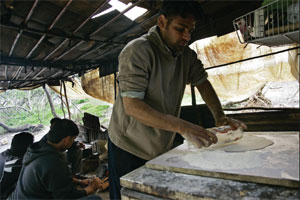 For many of us, the ability to live our lives in the diaspora is a direct consequence of journeys emanating from Punjab. Our fathers and mothers left economic insecurity and political uncertainty and set sail on ships and planes to far off backwaters in hopes of finding routes to the holy grails of North America and Europe. In today’s grapevine, it has become a casual affair to hear of Panamanian border crossings and Cuban raft rides. In a remarkable event, Spanish documentary film makers Alberto Garcia Ortiz and Agatha Maciaszek are currently in the process of filming the harrowing story of 54 Punjabi’s; who stranded in the Spanish city of Ceuta and fearing detention and deportation have fled and taken up refugee in the hills of the city.
For many of us, the ability to live our lives in the diaspora is a direct consequence of journeys emanating from Punjab. Our fathers and mothers left economic insecurity and political uncertainty and set sail on ships and planes to far off backwaters in hopes of finding routes to the holy grails of North America and Europe. In today’s grapevine, it has become a casual affair to hear of Panamanian border crossings and Cuban raft rides. In a remarkable event, Spanish documentary film makers Alberto Garcia Ortiz and Agatha Maciaszek are currently in the process of filming the harrowing story of 54 Punjabi’s; who stranded in the Spanish city of Ceuta and fearing detention and deportation have fled and taken up refugee in the hills of the city.
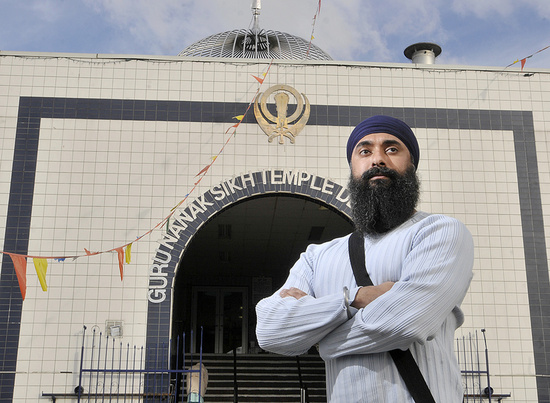 Many of the elements that make up this article have been featured in the Langar Hall in the past – Ranj Dhaliwal’s book Daaku about the lifestyle of Punjabi gangsters, thugs, and drug-dealers in BC during the late 1990s and early 2000s that cost the lives of 100+ youth in our community, Mani Amar’s film “A Warrior’s Religion” that documents the real life stories and effects of the peak of the violence, and finally to the various twists and turns that is British Columbia’s Sikh politics – from new coalitions to disputed certifications.
Many of the elements that make up this article have been featured in the Langar Hall in the past – Ranj Dhaliwal’s book Daaku about the lifestyle of Punjabi gangsters, thugs, and drug-dealers in BC during the late 1990s and early 2000s that cost the lives of 100+ youth in our community, Mani Amar’s film “A Warrior’s Religion” that documents the real life stories and effects of the peak of the violence, and finally to the various twists and turns that is British Columbia’s Sikh politics – from new coalitions to disputed certifications.
However, a recent article in The Walrus, author Timothy Taylor brings all these elements together in his piece, titled “Showdown on Scott Road.”
It might partly be the scarcity of female voices and public female faces in the Sikh community that makes Nikky-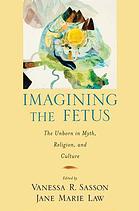 Guninder Kaur Singh’s so distinctive and refreshing. But in addition to her position as one of the few public female voices in the Sikh community, her original and creative work is really what makes Ms. Kaur-Singh so refreshing. As we have discussed in the past, in the context of “Relocating Gender in Sikh History,” the vast majority of Sikh history has been written by men. And thus, despite their best intentions, for the most part, women’s voice in Sikh history has been non-existent. It is silent.
Guninder Kaur Singh’s so distinctive and refreshing. But in addition to her position as one of the few public female voices in the Sikh community, her original and creative work is really what makes Ms. Kaur-Singh so refreshing. As we have discussed in the past, in the context of “Relocating Gender in Sikh History,” the vast majority of Sikh history has been written by men. And thus, despite their best intentions, for the most part, women’s voice in Sikh history has been non-existent. It is silent.
In this realm of mostly male voices, Ms. Kaur-Singh has taken an original position on a much-needed project: to explore a feminist perspective in interpreting Gurbani. Many translations of Gurbani have been written, some of which are quite good, and others that are quite lacking (in terms of staying close to the feeling of the original shabad and being easily understandable for today’s audiences). One of the most popular translations today, if not the most popular, is Sikhi to the Max. It’s heavily used in gurdwaras, at weddings, and by individuals at home. And in this translation, the divine is interpreted as He/Him/Lord. Not only is this archaic, it creates a framework of masculinity that limits our understanding of Waheguru. The Sikh conception of gender embraces as well as goes beyond gender.
In a piece we discovered recently, Ms. Kaur-Singh contrasts current practices of sex-selective abortion with the place of the feminine within Gurbani. In a chapter of “Imagining the Fetus: The Unborn in Myth, Religion, and Culture,” Ms. Kaur Singh orients readers with the history of sex-selection in Punjab. She then goes on to show how Gurbani holds the power to turn today’s practices on their head. In a few short pages, we are treated to a celebration of the feminine, reminded that our spirituality can focus on our source (the physical allegory of which is the mother) rather than its current infatuation with the end, and given a gender-neutral interpretation of excerpts of Gurbani which resonate as closer to a truer meaning than some other more widely used interpretations today.
 As all UK Sikhs or travelers to UK know at busy entries to the London Underground, you’ll find various vendors handing out free tabloids. Although everyone groans at the content, still enter the tube and you’ll find most busy Londoners flipping past the latest gossip on Paris Hilton or the recent election coverage in Afghanistan.
As all UK Sikhs or travelers to UK know at busy entries to the London Underground, you’ll find various vendors handing out free tabloids. Although everyone groans at the content, still enter the tube and you’ll find most busy Londoners flipping past the latest gossip on Paris Hilton or the recent election coverage in Afghanistan.
On Friday morning, many Londoners got a bright, colorful picture [click below the fold]. Although the content was nothing groundbreaking, still many of our Sikh readers (pagh salute: Joo Kay Singh) were pleased with the picture.
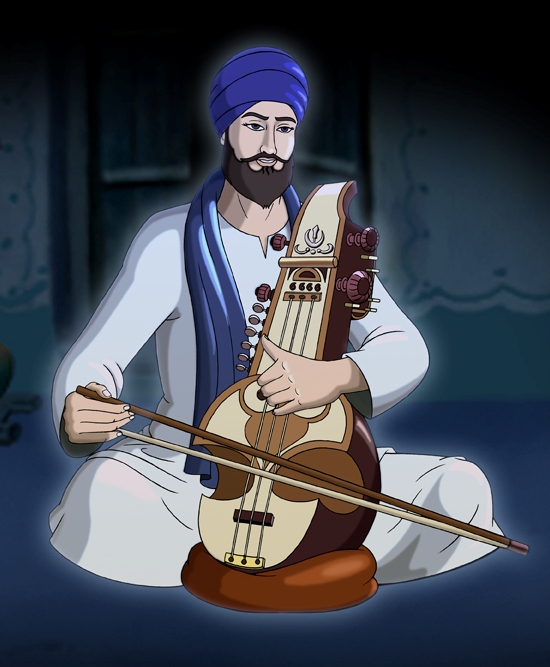 For those of you who enjoyed Vismaad Productions’ work with Sahibzadey, Rise of the Khalsa and Sundri, there is now a new animated movie to look forward to this fall. Bhai Taru Singh: True Saint. Fearless Soldier, is the latest production and will be premiering around the world over the next few months. The film’s website provides a description of the film,
For those of you who enjoyed Vismaad Productions’ work with Sahibzadey, Rise of the Khalsa and Sundri, there is now a new animated movie to look forward to this fall. Bhai Taru Singh: True Saint. Fearless Soldier, is the latest production and will be premiering around the world over the next few months. The film’s website provides a description of the film,
The story of Bhai Taru Singh is one of a true saint soldier who lived during an extremely difficult period for the Sikhs. The mughal rulers of the time were brutal towards all citizens, and especially the Sikhs. Bhai Taru Singh Ji bravely stood up to the regime which earned him the respect of all Hindus and Muslims from the surrounding villages. [link]
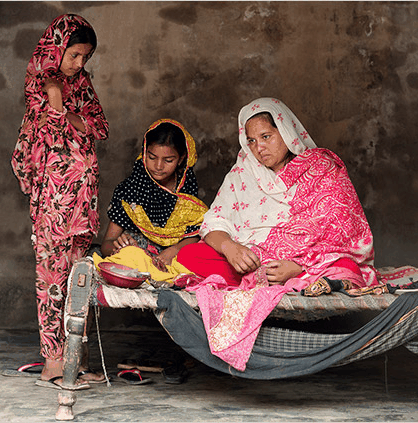 The issue of forced marriages and domestic violence clearly struck a chord with many of the TLH readers. But somewhere deep in the comments over titles, or whether these are Sikh or Punjabi issues, or whether or not we should air our “dirty laundry” in the first place – I feel some of the issues themselves got lost. In formulating my own thoughts on the topic and trying to build a broader perspective on women’s issues in general, I came across a fascinating article in last week’s New York Times Magazine called “Saving the World’s Women.” The premise of the article is that many of the countries that are disproportionately poverty-stricken and absorbed in fundamentalism and chaos, are also those same countries where women are the least educated and most marginalized. And by focusing (and investing) on women and girls, a dramatic impact can be made to fight global poverty and extremism.
The issue of forced marriages and domestic violence clearly struck a chord with many of the TLH readers. But somewhere deep in the comments over titles, or whether these are Sikh or Punjabi issues, or whether or not we should air our “dirty laundry” in the first place – I feel some of the issues themselves got lost. In formulating my own thoughts on the topic and trying to build a broader perspective on women’s issues in general, I came across a fascinating article in last week’s New York Times Magazine called “Saving the World’s Women.” The premise of the article is that many of the countries that are disproportionately poverty-stricken and absorbed in fundamentalism and chaos, are also those same countries where women are the least educated and most marginalized. And by focusing (and investing) on women and girls, a dramatic impact can be made to fight global poverty and extremism.
Take the example of Saima Muhammad (pictured above) from Pakistan. Saima didn’t have a rupee to her name, was routinely beaten by her unemployed husband and other family members, and had to send her kids away due to lack of food and other basics. Even her mother-in-law contributed to her troubles by encouraging her son to marry again because Saima was only giving birth to girls. However, after Saima signed up with the Kashf Foundation, a Pakistani microfinance organization, things turned around.
Saima took out a $65 loan and used the money to buy beads and cloth, which she transformed into beautiful embroidery that she then sold to merchants in the markets of Lahore. She used the profit to buy more beads and cloth, and soon she had an embroidery business and was earning a solid income — the only one in her household to do so. Saima took her elder daughter back from the aunt and began paying off her husband’s debt.
…Saima became the tycoon of the neighborhood, and she was able to pay off her husband’s entire debt, keep her daughters in school, renovate the house, connect running water and buy a television.
As the economics of Saima’s situation changed, so did the relationship with her family. She now has a better relationship with her family and has earned their respect. It is unfortunate that this is what it took for Saima, and many will never have the golden opportunity Saima had, but it does send a clear message – that although it may seem impossible to break down cultural barriers, economics can change the game quickly.
 The issue of the loss of Sikh heritage sites and documents has long been lamented by many Sikhs. In fact, one of my fellow langa(w)riters blogged about the need to ‘preserve what history we have left.’ One group has been silently seeking to remedy this problem – the Nanakshahi Trust.
The issue of the loss of Sikh heritage sites and documents has long been lamented by many Sikhs. In fact, one of my fellow langa(w)riters blogged about the need to ‘preserve what history we have left.’ One group has been silently seeking to remedy this problem – the Nanakshahi Trust.
Quietly working on a massive project for over the past 6 years, the Nanakshahi Trust, along with the Sikh Research Institute, have inaugurated the Panjabi Digital Library:
For the first time ever a searchable collection of millions of rare pages on the Sikhs and the region of Panjab has been made available. Panjab Digital Library (PDL) will include texts of manuscripts, books, magazines, newspapers and photographs and will be available to anyone with Internet access at www.PanjabDigiLib.org. This launch was made possible in part by The Nanakshahi Trust and the Sikh Research Institute (SikhRI).
In today’s society, digitization is the key to immortality. While Sikhs have to be equally wary of those that claim Sikhs have no history as well as those that come up with their own ludicrous interpretations, a project such as the Panjab Digital Library allows Sikhs to access their own primary and secondary sources. Nanakshahi Trust has done a tremendous boon to Sikhs, researchers, and all that are interested in the preservation of history and man (and woman’s) historical past.
Blogged by: sikhpulse
The Christian community is confronting the development of the “Sixth American:” those individuals who do not exist in or identify with any particular space and ultimately congregate together. These integrated congregations are hopeful signs that the elements of discrimination and racism which infiltrated most churches over the last two centuries are slowly being eradicated.
Strangely enough, Sikh-Americans aren’t evolving in the same direction. In less than fifty years, Sikh-Americans have (get this) provided an anti-model for our adopted culture by dividing into self-identifying congregations, sects and denominations!
This may in part be explained by our natural connection to our social networks. Like members of other faiths, we choose to go to a place of worship that is attended by our families. We go where our friends attend. We go where our language is spoken. We are segregated by whether we are brand-spankin-new-citizens or third-generation Sikh Americans. We are separated by our interests and our jobs.
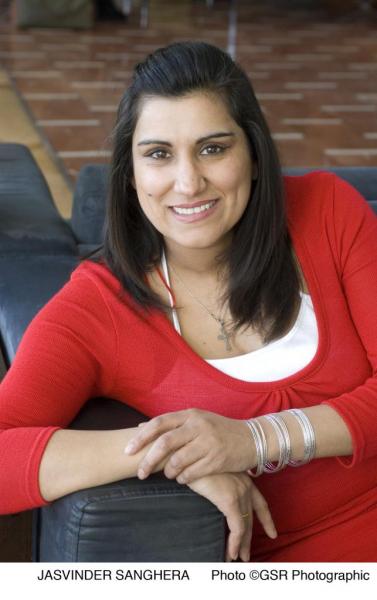 The issue of marriage is complex and has as many circumstances as there are combinations of people in the world. Recently, a langa(r)eader wrote:
The issue of marriage is complex and has as many circumstances as there are combinations of people in the world. Recently, a langa(r)eader wrote:
Hi I as just wonderingif you are familiar at all with a sikh girl marrying a non sikh guy who is caucasian. Her parents banished her forever about 7 years ago and then finally contacted about 2 years ago but are still hung up on the fact. Just wondering what we can do to help them get over this faster. [received email]
Well I can’t make the parents ‘get over this faster’, but I can raise some observations and thoughts on marriage.
Blogged by: Amol Singh
A new generation of Sikh youth is coming up to age in a diaspora still unable to decently reflect or respond to the tragedies that have befallen the Panth. Although, cognizant of the injustices done to Sikhs, we have categorically failed at identifying a half-way legitimate vision for our institutions.The following is a humble attempt at one such institution, hinted at by an older post.
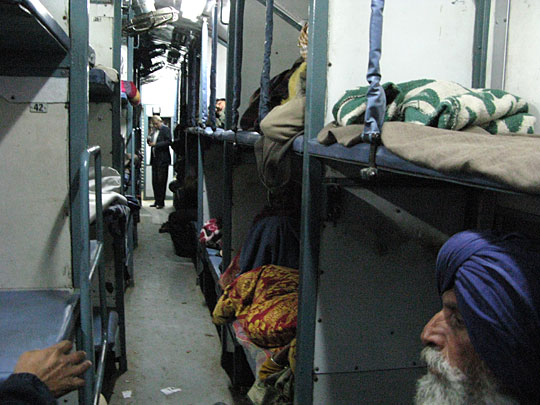
Much of Punjab’s money flow is due to remittances from family members scattered across the globe. However, remittances are easily subjected to ebb and flows in the world’s markets and these flows of money to Punjab can be easily disrupted by economic downturns. In addition, Punjab receives little attention from international development agencies. For instance, there are currently a total of two World Bank projects targeting the state. Unfortunately, Punjab is receiving more attention from MNC’s and the introduction of SEZ’s inside the state is unnerving to many who believe that they foreshadow an increase in neoliberal market practices favoring large corporations.
In my opinion, Punjab needs an insertion of human and financial capital that can ignite a grassroots based economic revival that quantifies development on the creation of ecologically friendly infrastructure. To being the process for these goals, I propose the creation of a development bank.
